CHCECE021/023: Child Inclusion Strategies & Learning Record Analysis
VerifiedAdded on 2023/06/04
|19
|5578
|289
Practical Assignment
AI Summary
This assignment provides solutions for CHCECE021 (implementing inclusion strategies for all children) and CHCECE023 (analysing information to inform learning records). For CHCECE021, it includes a child profile with background information, abilities, interests, expectations, health status, needs, potential barriers, and a child support plan with adaptations and resources. The CHCECE023 section features infant and toddler observation records, detailing behaviour, family circumstances, developmental skills, play preferences, strengths, health status, barriers to learning, and collaboration with families and specialists, ultimately planning responsive learning experiences based on gathered information.
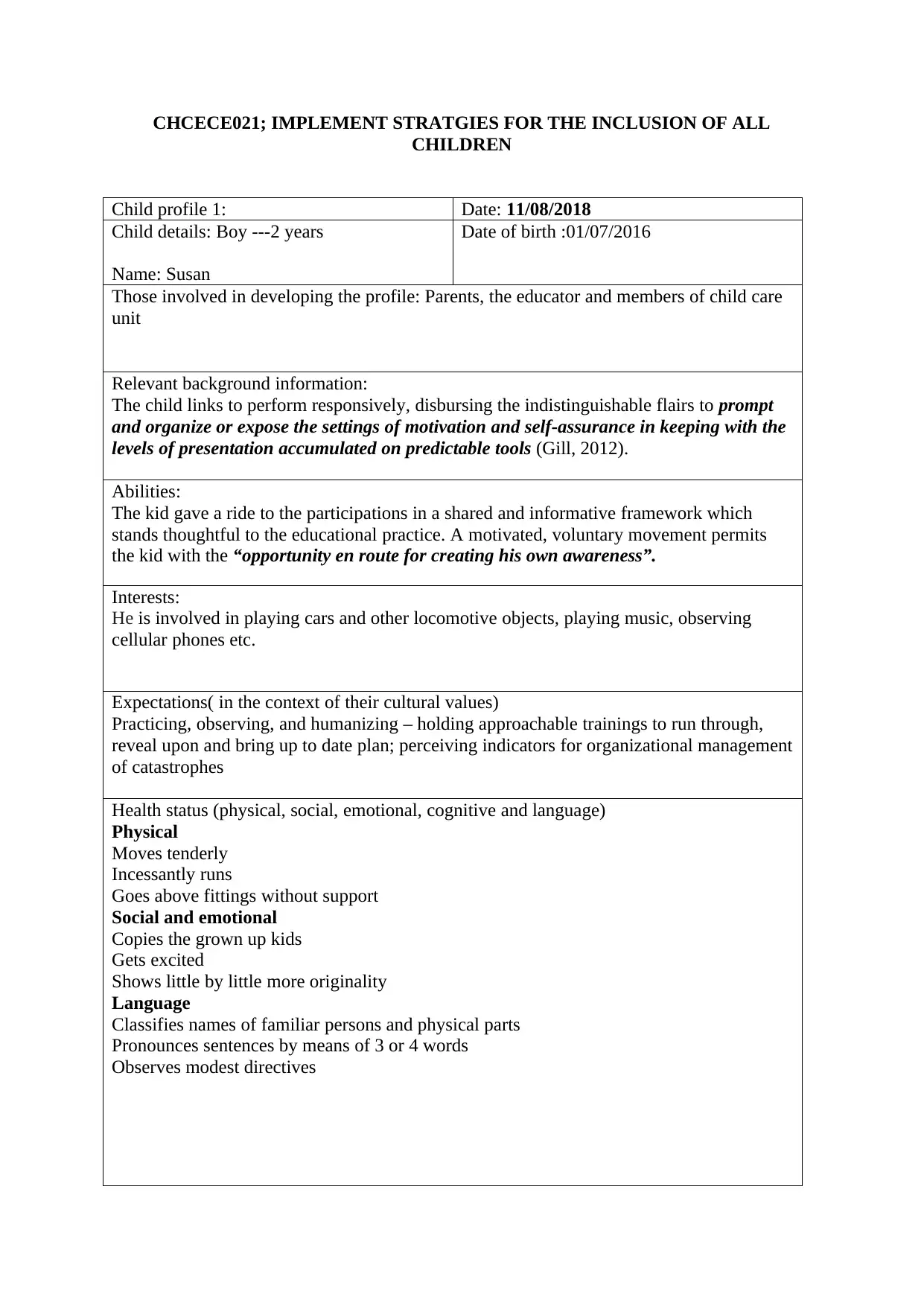
CHCECE021; IMPLEMENT STRATGIES FOR THE INCLUSION OF ALL
CHILDREN
Child profile 1: Date: 11/08/2018
Child details: Boy ---2 years
Name: Susan
Date of birth :01/07/2016
Those involved in developing the profile: Parents, the educator and members of child care
unit
Relevant background information:
The child links to perform responsively, disbursing the indistinguishable flairs to prompt
and organize or expose the settings of motivation and self-assurance in keeping with the
levels of presentation accumulated on predictable tools (Gill, 2012).
Abilities:
The kid gave a ride to the participations in a shared and informative framework which
stands thoughtful to the educational practice. A motivated, voluntary movement permits
the kid with the “opportunity en route for creating his own awareness”.
Interests:
He is involved in playing cars and other locomotive objects, playing music, observing
cellular phones etc.
Expectations( in the context of their cultural values)
Practicing, observing, and humanizing – holding approachable trainings to run through,
reveal upon and bring up to date plan; perceiving indicators for organizational management
of catastrophes
Health status (physical, social, emotional, cognitive and language)
Physical
Moves tenderly
Incessantly runs
Goes above fittings without support
Social and emotional
Copies the grown up kids
Gets excited
Shows little by little more originality
Language
Classifies names of familiar persons and physical parts
Pronounces sentences by means of 3 or 4 words
Observes modest directives
CHILDREN
Child profile 1: Date: 11/08/2018
Child details: Boy ---2 years
Name: Susan
Date of birth :01/07/2016
Those involved in developing the profile: Parents, the educator and members of child care
unit
Relevant background information:
The child links to perform responsively, disbursing the indistinguishable flairs to prompt
and organize or expose the settings of motivation and self-assurance in keeping with the
levels of presentation accumulated on predictable tools (Gill, 2012).
Abilities:
The kid gave a ride to the participations in a shared and informative framework which
stands thoughtful to the educational practice. A motivated, voluntary movement permits
the kid with the “opportunity en route for creating his own awareness”.
Interests:
He is involved in playing cars and other locomotive objects, playing music, observing
cellular phones etc.
Expectations( in the context of their cultural values)
Practicing, observing, and humanizing – holding approachable trainings to run through,
reveal upon and bring up to date plan; perceiving indicators for organizational management
of catastrophes
Health status (physical, social, emotional, cognitive and language)
Physical
Moves tenderly
Incessantly runs
Goes above fittings without support
Social and emotional
Copies the grown up kids
Gets excited
Shows little by little more originality
Language
Classifies names of familiar persons and physical parts
Pronounces sentences by means of 3 or 4 words
Observes modest directives
Paraphrase This Document
Need a fresh take? Get an instant paraphrase of this document with our AI Paraphraser
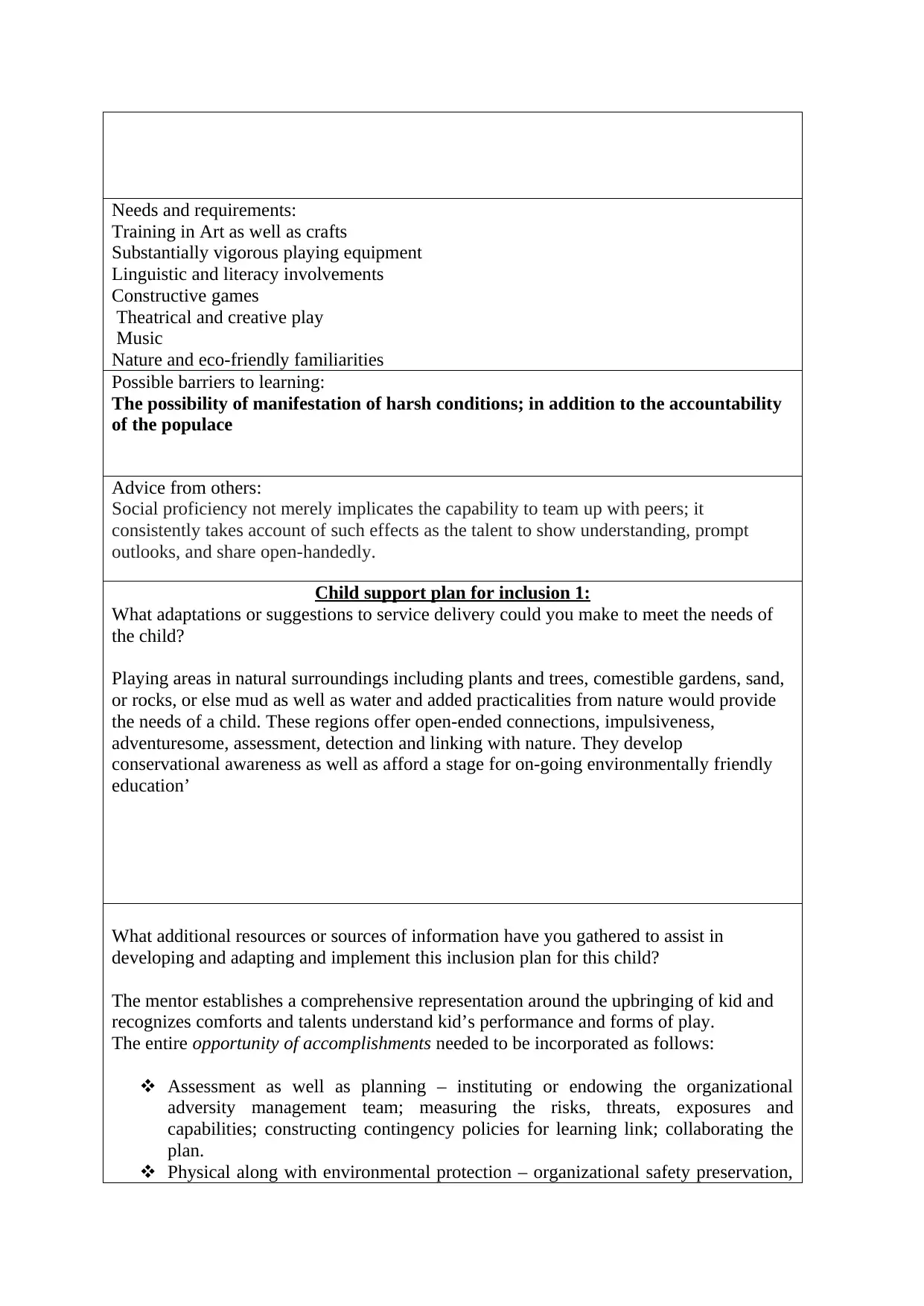
Needs and requirements:
Training in Art as well as crafts
Substantially vigorous playing equipment
Linguistic and literacy involvements
Constructive games
Theatrical and creative play
Music
Nature and eco-friendly familiarities
Possible barriers to learning:
The possibility of manifestation of harsh conditions; in addition to the accountability
of the populace
Advice from others:
Social proficiency not merely implicates the capability to team up with peers; it
consistently takes account of such effects as the talent to show understanding, prompt
outlooks, and share open-handedly.
Child support plan for inclusion 1:
What adaptations or suggestions to service delivery could you make to meet the needs of
the child?
Playing areas in natural surroundings including plants and trees, comestible gardens, sand,
or rocks, or else mud as well as water and added practicalities from nature would provide
the needs of a child. These regions offer open-ended connections, impulsiveness,
adventuresome, assessment, detection and linking with nature. They develop
conservational awareness as well as afford a stage for on-going environmentally friendly
education’
What additional resources or sources of information have you gathered to assist in
developing and adapting and implement this inclusion plan for this child?
The mentor establishes a comprehensive representation around the upbringing of kid and
recognizes comforts and talents understand kid’s performance and forms of play.
The entire opportunity of accomplishments needed to be incorporated as follows:
Assessment as well as planning – instituting or endowing the organizational
adversity management team; measuring the risks, threats, exposures and
capabilities; constructing contingency policies for learning link; collaborating the
plan.
Physical along with environmental protection – organizational safety preservation,
Training in Art as well as crafts
Substantially vigorous playing equipment
Linguistic and literacy involvements
Constructive games
Theatrical and creative play
Music
Nature and eco-friendly familiarities
Possible barriers to learning:
The possibility of manifestation of harsh conditions; in addition to the accountability
of the populace
Advice from others:
Social proficiency not merely implicates the capability to team up with peers; it
consistently takes account of such effects as the talent to show understanding, prompt
outlooks, and share open-handedly.
Child support plan for inclusion 1:
What adaptations or suggestions to service delivery could you make to meet the needs of
the child?
Playing areas in natural surroundings including plants and trees, comestible gardens, sand,
or rocks, or else mud as well as water and added practicalities from nature would provide
the needs of a child. These regions offer open-ended connections, impulsiveness,
adventuresome, assessment, detection and linking with nature. They develop
conservational awareness as well as afford a stage for on-going environmentally friendly
education’
What additional resources or sources of information have you gathered to assist in
developing and adapting and implement this inclusion plan for this child?
The mentor establishes a comprehensive representation around the upbringing of kid and
recognizes comforts and talents understand kid’s performance and forms of play.
The entire opportunity of accomplishments needed to be incorporated as follows:
Assessment as well as planning – instituting or endowing the organizational
adversity management team; measuring the risks, threats, exposures and
capabilities; constructing contingency policies for learning link; collaborating the
plan.
Physical along with environmental protection – organizational safety preservation,
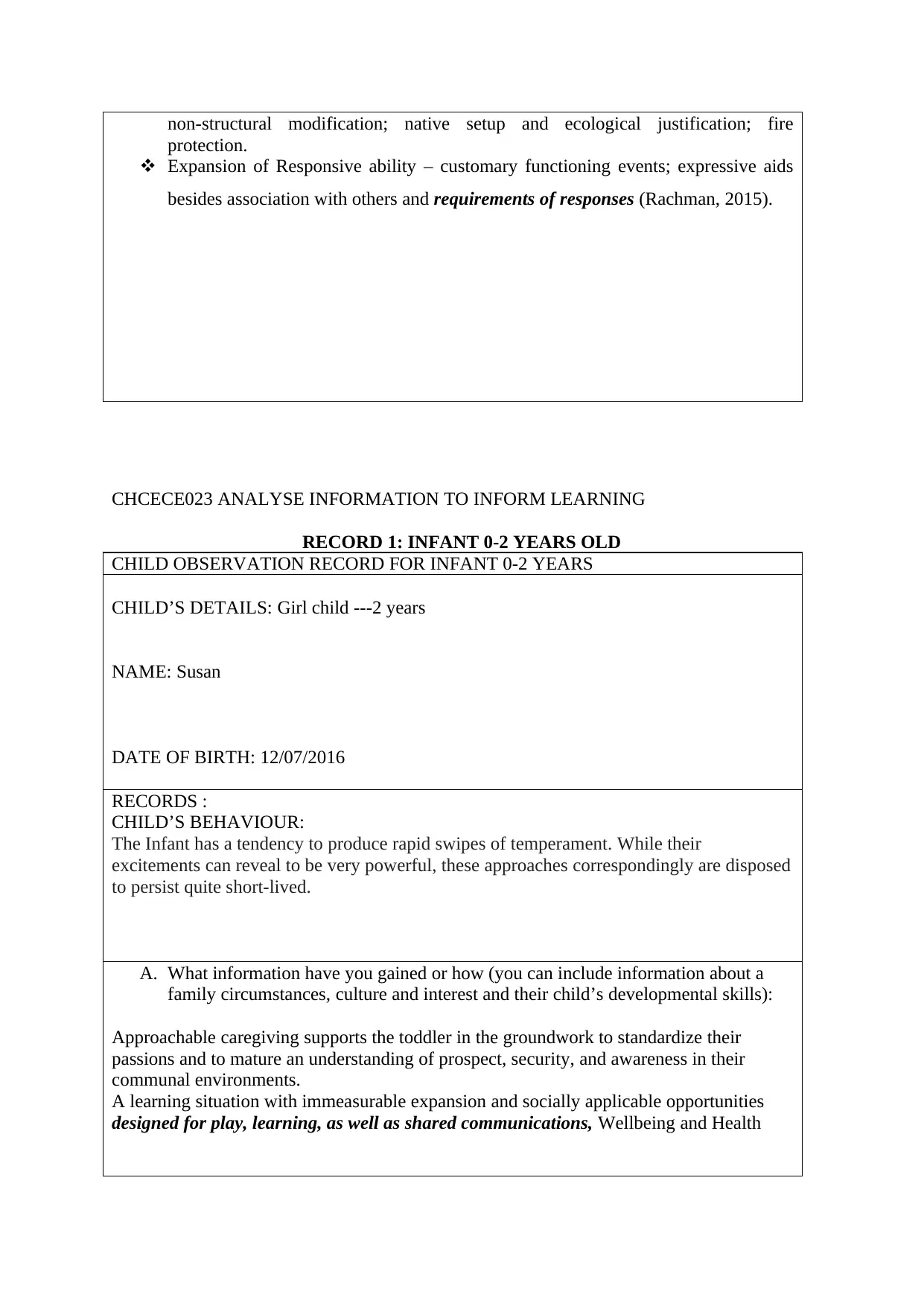
non-structural modification; native setup and ecological justification; fire
protection.
Expansion of Responsive ability – customary functioning events; expressive aids
besides association with others and requirements of responses (Rachman, 2015).
CHCECE023 ANALYSE INFORMATION TO INFORM LEARNING
RECORD 1: INFANT 0-2 YEARS OLD
CHILD OBSERVATION RECORD FOR INFANT 0-2 YEARS
CHILD’S DETAILS: Girl child ---2 years
NAME: Susan
DATE OF BIRTH: 12/07/2016
RECORDS :
CHILD’S BEHAVIOUR:
The Infant has a tendency to produce rapid swipes of temperament. While their
excitements can reveal to be very powerful, these approaches correspondingly are disposed
to persist quite short-lived.
A. What information have you gained or how (you can include information about a
family circumstances, culture and interest and their child’s developmental skills):
Approachable caregiving supports the toddler in the groundwork to standardize their
passions and to mature an understanding of prospect, security, and awareness in their
communal environments.
A learning situation with immeasurable expansion and socially applicable opportunities
designed for play, learning, as well as shared communications, Wellbeing and Health
protection.
Expansion of Responsive ability – customary functioning events; expressive aids
besides association with others and requirements of responses (Rachman, 2015).
CHCECE023 ANALYSE INFORMATION TO INFORM LEARNING
RECORD 1: INFANT 0-2 YEARS OLD
CHILD OBSERVATION RECORD FOR INFANT 0-2 YEARS
CHILD’S DETAILS: Girl child ---2 years
NAME: Susan
DATE OF BIRTH: 12/07/2016
RECORDS :
CHILD’S BEHAVIOUR:
The Infant has a tendency to produce rapid swipes of temperament. While their
excitements can reveal to be very powerful, these approaches correspondingly are disposed
to persist quite short-lived.
A. What information have you gained or how (you can include information about a
family circumstances, culture and interest and their child’s developmental skills):
Approachable caregiving supports the toddler in the groundwork to standardize their
passions and to mature an understanding of prospect, security, and awareness in their
communal environments.
A learning situation with immeasurable expansion and socially applicable opportunities
designed for play, learning, as well as shared communications, Wellbeing and Health
⊘ This is a preview!⊘
Do you want full access?
Subscribe today to unlock all pages.

Trusted by 1+ million students worldwide
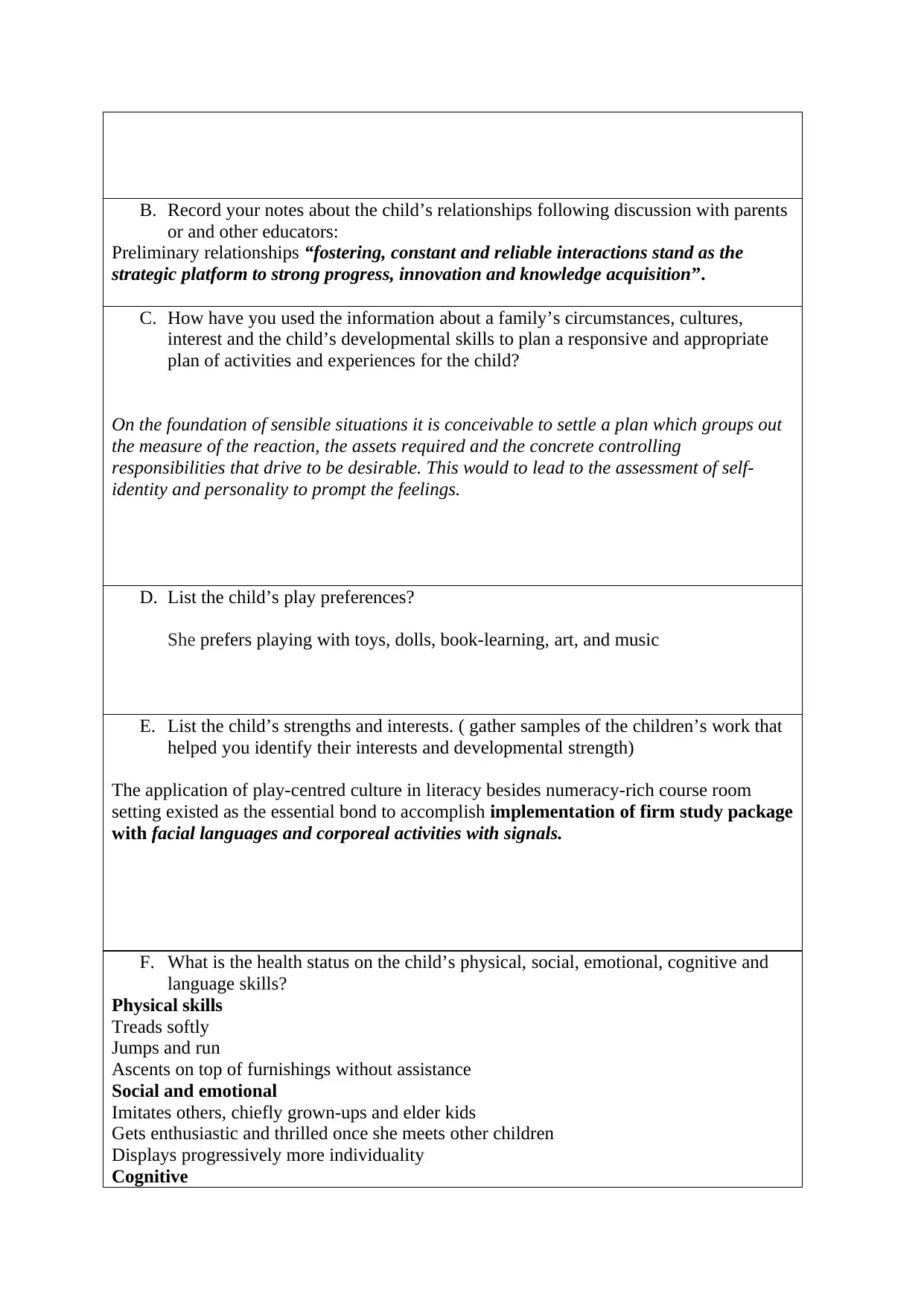
B. Record your notes about the child’s relationships following discussion with parents
or and other educators:
Preliminary relationships “fostering, constant and reliable interactions stand as the
strategic platform to strong progress, innovation and knowledge acquisition”.
C. How have you used the information about a family’s circumstances, cultures,
interest and the child’s developmental skills to plan a responsive and appropriate
plan of activities and experiences for the child?
On the foundation of sensible situations it is conceivable to settle a plan which groups out
the measure of the reaction, the assets required and the concrete controlling
responsibilities that drive to be desirable. This would to lead to the assessment of self-
identity and personality to prompt the feelings.
D. List the child’s play preferences?
She prefers playing with toys, dolls, book-learning, art, and music
E. List the child’s strengths and interests. ( gather samples of the children’s work that
helped you identify their interests and developmental strength)
The application of play-centred culture in literacy besides numeracy-rich course room
setting existed as the essential bond to accomplish implementation of firm study package
with facial languages and corporeal activities with signals.
F. What is the health status on the child’s physical, social, emotional, cognitive and
language skills?
Physical skills
Treads softly
Jumps and run
Ascents on top of furnishings without assistance
Social and emotional
Imitates others, chiefly grown-ups and elder kids
Gets enthusiastic and thrilled once she meets other children
Displays progressively more individuality
Cognitive
or and other educators:
Preliminary relationships “fostering, constant and reliable interactions stand as the
strategic platform to strong progress, innovation and knowledge acquisition”.
C. How have you used the information about a family’s circumstances, cultures,
interest and the child’s developmental skills to plan a responsive and appropriate
plan of activities and experiences for the child?
On the foundation of sensible situations it is conceivable to settle a plan which groups out
the measure of the reaction, the assets required and the concrete controlling
responsibilities that drive to be desirable. This would to lead to the assessment of self-
identity and personality to prompt the feelings.
D. List the child’s play preferences?
She prefers playing with toys, dolls, book-learning, art, and music
E. List the child’s strengths and interests. ( gather samples of the children’s work that
helped you identify their interests and developmental strength)
The application of play-centred culture in literacy besides numeracy-rich course room
setting existed as the essential bond to accomplish implementation of firm study package
with facial languages and corporeal activities with signals.
F. What is the health status on the child’s physical, social, emotional, cognitive and
language skills?
Physical skills
Treads softly
Jumps and run
Ascents on top of furnishings without assistance
Social and emotional
Imitates others, chiefly grown-ups and elder kids
Gets enthusiastic and thrilled once she meets other children
Displays progressively more individuality
Cognitive
Paraphrase This Document
Need a fresh take? Get an instant paraphrase of this document with our AI Paraphraser
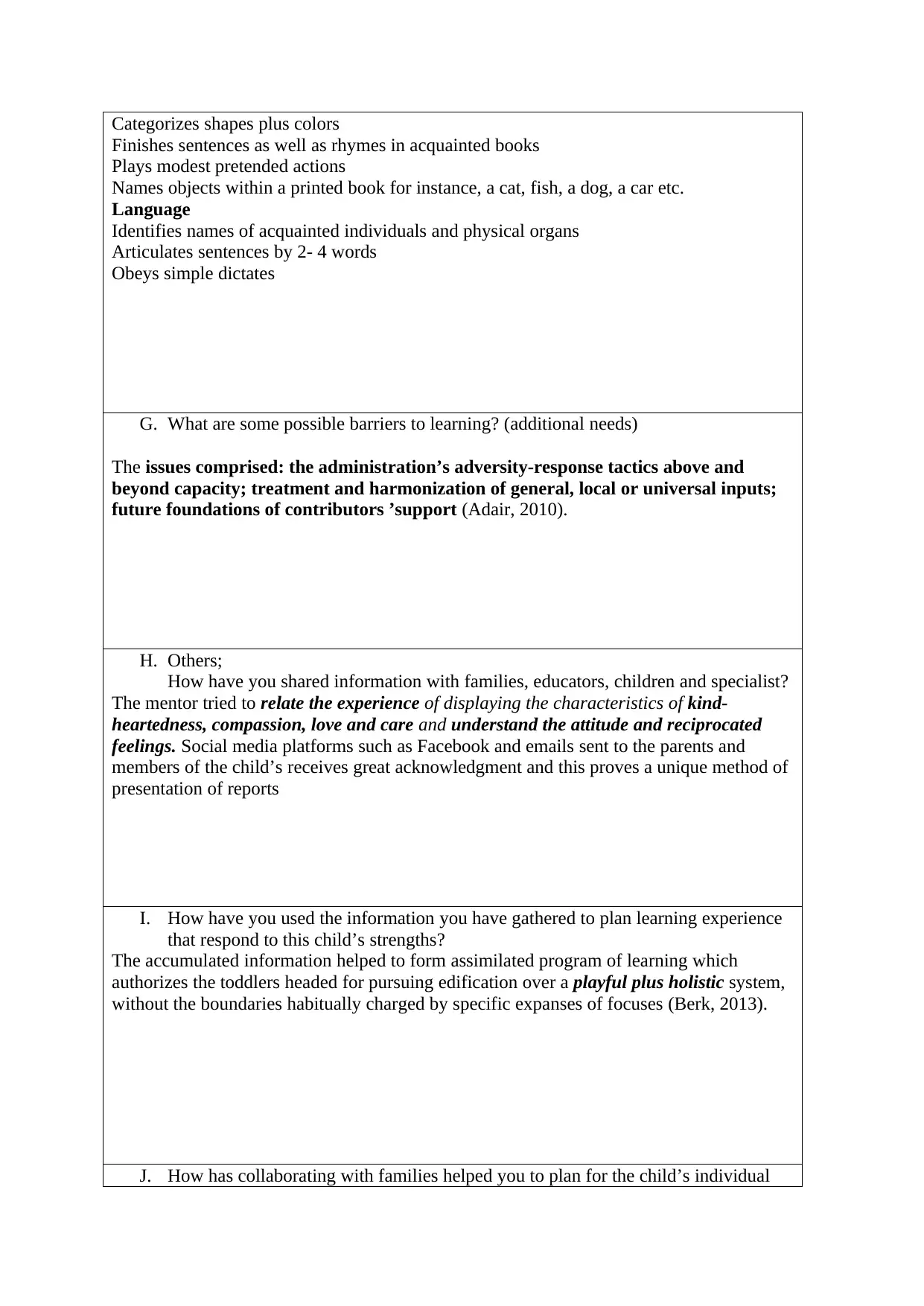
Categorizes shapes plus colors
Finishes sentences as well as rhymes in acquainted books
Plays modest pretended actions
Names objects within a printed book for instance, a cat, fish, a dog, a car etc.
Language
Identifies names of acquainted individuals and physical organs
Articulates sentences by 2- 4 words
Obeys simple dictates
G. What are some possible barriers to learning? (additional needs)
The issues comprised: the administration’s adversity-response tactics above and
beyond capacity; treatment and harmonization of general, local or universal inputs;
future foundations of contributors ’support (Adair, 2010).
H. Others;
How have you shared information with families, educators, children and specialist?
The mentor tried to relate the experience of displaying the characteristics of kind-
heartedness, compassion, love and care and understand the attitude and reciprocated
feelings. Social media platforms such as Facebook and emails sent to the parents and
members of the child’s receives great acknowledgment and this proves a unique method of
presentation of reports
I. How have you used the information you have gathered to plan learning experience
that respond to this child’s strengths?
The accumulated information helped to form assimilated program of learning which
authorizes the toddlers headed for pursuing edification over a playful plus holistic system,
without the boundaries habitually charged by specific expanses of focuses (Berk, 2013).
J. How has collaborating with families helped you to plan for the child’s individual
Finishes sentences as well as rhymes in acquainted books
Plays modest pretended actions
Names objects within a printed book for instance, a cat, fish, a dog, a car etc.
Language
Identifies names of acquainted individuals and physical organs
Articulates sentences by 2- 4 words
Obeys simple dictates
G. What are some possible barriers to learning? (additional needs)
The issues comprised: the administration’s adversity-response tactics above and
beyond capacity; treatment and harmonization of general, local or universal inputs;
future foundations of contributors ’support (Adair, 2010).
H. Others;
How have you shared information with families, educators, children and specialist?
The mentor tried to relate the experience of displaying the characteristics of kind-
heartedness, compassion, love and care and understand the attitude and reciprocated
feelings. Social media platforms such as Facebook and emails sent to the parents and
members of the child’s receives great acknowledgment and this proves a unique method of
presentation of reports
I. How have you used the information you have gathered to plan learning experience
that respond to this child’s strengths?
The accumulated information helped to form assimilated program of learning which
authorizes the toddlers headed for pursuing edification over a playful plus holistic system,
without the boundaries habitually charged by specific expanses of focuses (Berk, 2013).
J. How has collaborating with families helped you to plan for the child’s individual
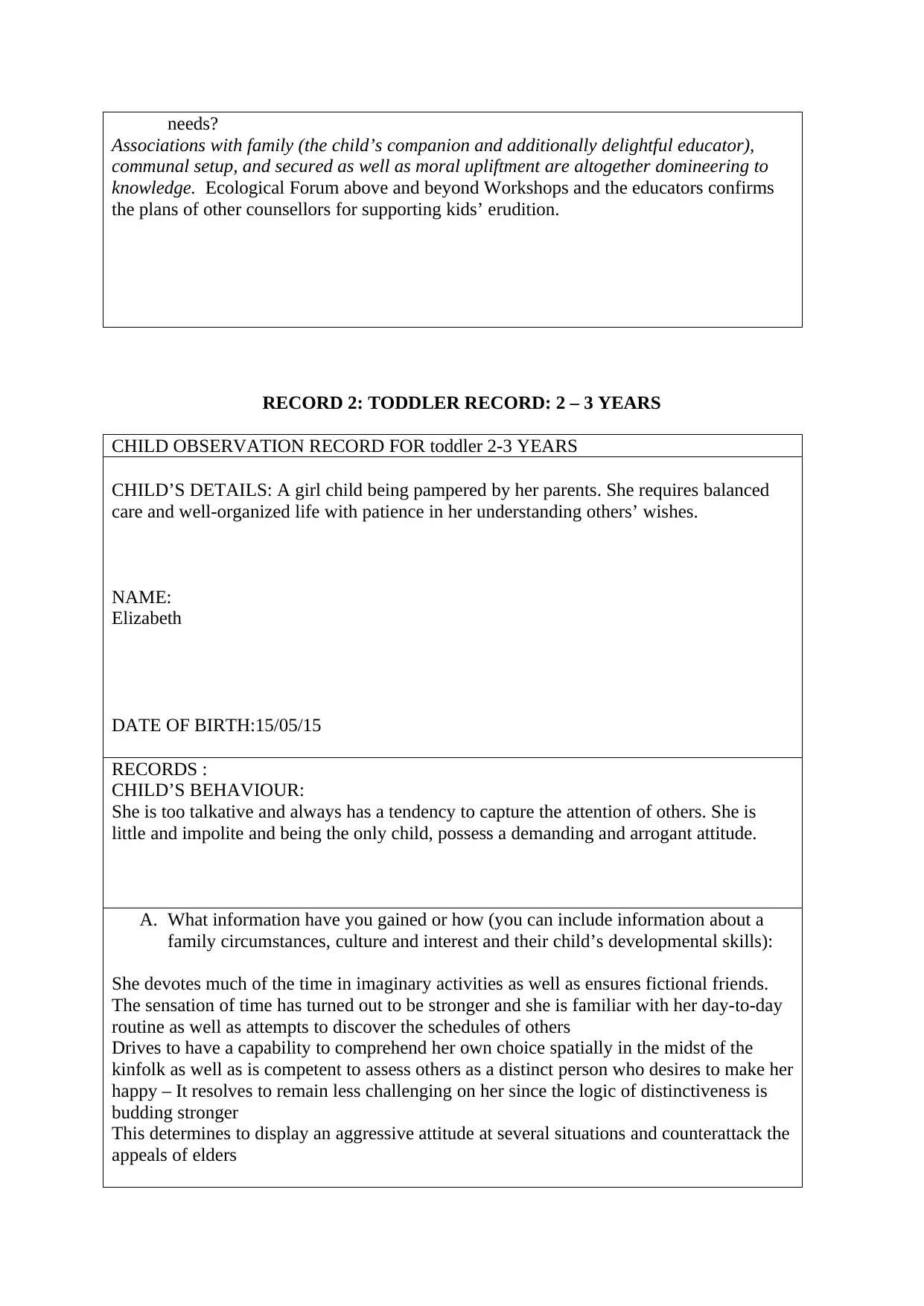
needs?
Associations with family (the child’s companion and additionally delightful educator),
communal setup, and secured as well as moral upliftment are altogether domineering to
knowledge. Ecological Forum above and beyond Workshops and the educators confirms
the plans of other counsellors for supporting kids’ erudition.
RECORD 2: TODDLER RECORD: 2 – 3 YEARS
CHILD OBSERVATION RECORD FOR toddler 2-3 YEARS
CHILD’S DETAILS: A girl child being pampered by her parents. She requires balanced
care and well-organized life with patience in her understanding others’ wishes.
NAME:
Elizabeth
DATE OF BIRTH:15/05/15
RECORDS :
CHILD’S BEHAVIOUR:
She is too talkative and always has a tendency to capture the attention of others. She is
little and impolite and being the only child, possess a demanding and arrogant attitude.
A. What information have you gained or how (you can include information about a
family circumstances, culture and interest and their child’s developmental skills):
She devotes much of the time in imaginary activities as well as ensures fictional friends.
The sensation of time has turned out to be stronger and she is familiar with her day-to-day
routine as well as attempts to discover the schedules of others
Drives to have a capability to comprehend her own choice spatially in the midst of the
kinfolk as well as is competent to assess others as a distinct person who desires to make her
happy – It resolves to remain less challenging on her since the logic of distinctiveness is
budding stronger
This determines to display an aggressive attitude at several situations and counterattack the
appeals of elders
Associations with family (the child’s companion and additionally delightful educator),
communal setup, and secured as well as moral upliftment are altogether domineering to
knowledge. Ecological Forum above and beyond Workshops and the educators confirms
the plans of other counsellors for supporting kids’ erudition.
RECORD 2: TODDLER RECORD: 2 – 3 YEARS
CHILD OBSERVATION RECORD FOR toddler 2-3 YEARS
CHILD’S DETAILS: A girl child being pampered by her parents. She requires balanced
care and well-organized life with patience in her understanding others’ wishes.
NAME:
Elizabeth
DATE OF BIRTH:15/05/15
RECORDS :
CHILD’S BEHAVIOUR:
She is too talkative and always has a tendency to capture the attention of others. She is
little and impolite and being the only child, possess a demanding and arrogant attitude.
A. What information have you gained or how (you can include information about a
family circumstances, culture and interest and their child’s developmental skills):
She devotes much of the time in imaginary activities as well as ensures fictional friends.
The sensation of time has turned out to be stronger and she is familiar with her day-to-day
routine as well as attempts to discover the schedules of others
Drives to have a capability to comprehend her own choice spatially in the midst of the
kinfolk as well as is competent to assess others as a distinct person who desires to make her
happy – It resolves to remain less challenging on her since the logic of distinctiveness is
budding stronger
This determines to display an aggressive attitude at several situations and counterattack the
appeals of elders
⊘ This is a preview!⊘
Do you want full access?
Subscribe today to unlock all pages.

Trusted by 1+ million students worldwide
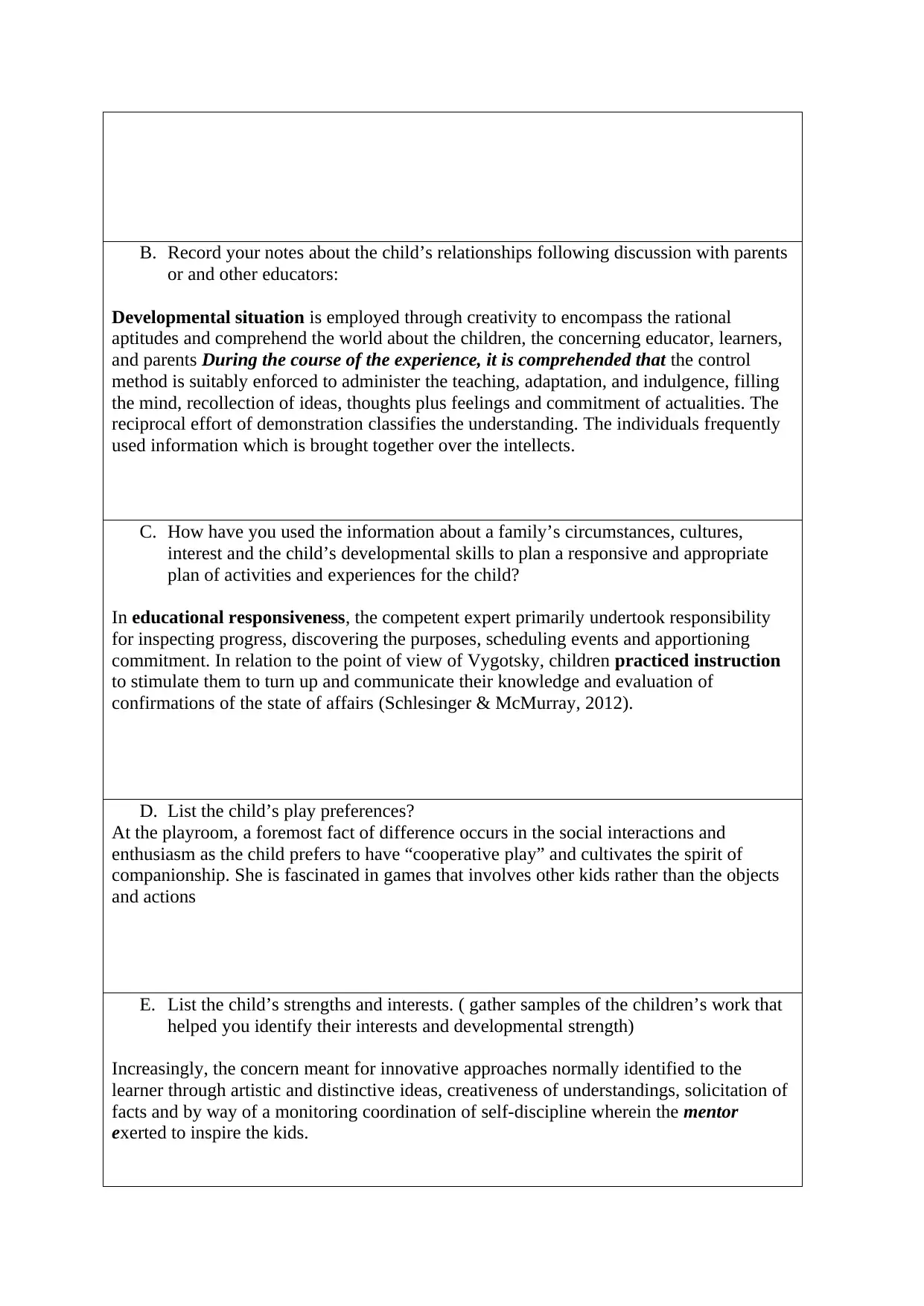
B. Record your notes about the child’s relationships following discussion with parents
or and other educators:
Developmental situation is employed through creativity to encompass the rational
aptitudes and comprehend the world about the children, the concerning educator, learners,
and parents During the course of the experience, it is comprehended that the control
method is suitably enforced to administer the teaching, adaptation, and indulgence, filling
the mind, recollection of ideas, thoughts plus feelings and commitment of actualities. The
reciprocal effort of demonstration classifies the understanding. The individuals frequently
used information which is brought together over the intellects.
C. How have you used the information about a family’s circumstances, cultures,
interest and the child’s developmental skills to plan a responsive and appropriate
plan of activities and experiences for the child?
In educational responsiveness, the competent expert primarily undertook responsibility
for inspecting progress, discovering the purposes, scheduling events and apportioning
commitment. In relation to the point of view of Vygotsky, children practiced instruction
to stimulate them to turn up and communicate their knowledge and evaluation of
confirmations of the state of affairs (Schlesinger & McMurray, 2012).
D. List the child’s play preferences?
At the playroom, a foremost fact of difference occurs in the social interactions and
enthusiasm as the child prefers to have “cooperative play” and cultivates the spirit of
companionship. She is fascinated in games that involves other kids rather than the objects
and actions
E. List the child’s strengths and interests. ( gather samples of the children’s work that
helped you identify their interests and developmental strength)
Increasingly, the concern meant for innovative approaches normally identified to the
learner through artistic and distinctive ideas, creativeness of understandings, solicitation of
facts and by way of a monitoring coordination of self-discipline wherein the mentor
exerted to inspire the kids.
or and other educators:
Developmental situation is employed through creativity to encompass the rational
aptitudes and comprehend the world about the children, the concerning educator, learners,
and parents During the course of the experience, it is comprehended that the control
method is suitably enforced to administer the teaching, adaptation, and indulgence, filling
the mind, recollection of ideas, thoughts plus feelings and commitment of actualities. The
reciprocal effort of demonstration classifies the understanding. The individuals frequently
used information which is brought together over the intellects.
C. How have you used the information about a family’s circumstances, cultures,
interest and the child’s developmental skills to plan a responsive and appropriate
plan of activities and experiences for the child?
In educational responsiveness, the competent expert primarily undertook responsibility
for inspecting progress, discovering the purposes, scheduling events and apportioning
commitment. In relation to the point of view of Vygotsky, children practiced instruction
to stimulate them to turn up and communicate their knowledge and evaluation of
confirmations of the state of affairs (Schlesinger & McMurray, 2012).
D. List the child’s play preferences?
At the playroom, a foremost fact of difference occurs in the social interactions and
enthusiasm as the child prefers to have “cooperative play” and cultivates the spirit of
companionship. She is fascinated in games that involves other kids rather than the objects
and actions
E. List the child’s strengths and interests. ( gather samples of the children’s work that
helped you identify their interests and developmental strength)
Increasingly, the concern meant for innovative approaches normally identified to the
learner through artistic and distinctive ideas, creativeness of understandings, solicitation of
facts and by way of a monitoring coordination of self-discipline wherein the mentor
exerted to inspire the kids.
Paraphrase This Document
Need a fresh take? Get an instant paraphrase of this document with our AI Paraphraser
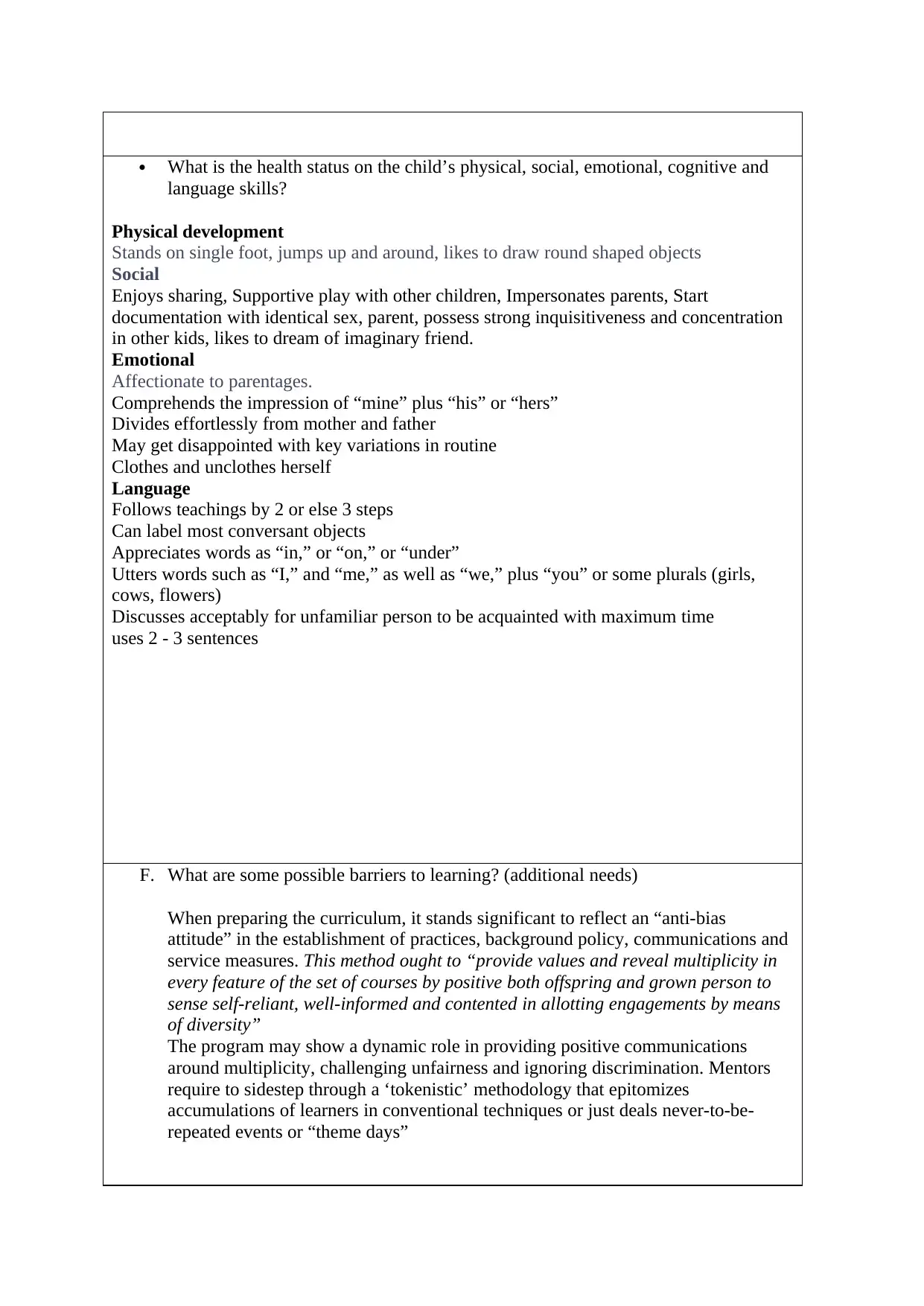
What is the health status on the child’s physical, social, emotional, cognitive and
language skills?
Physical development
Stands on single foot, jumps up and around, likes to draw round shaped objects
Social
Enjoys sharing, Supportive play with other children, Impersonates parents, Start
documentation with identical sex, parent, possess strong inquisitiveness and concentration
in other kids, likes to dream of imaginary friend.
Emotional
Affectionate to parentages.
Comprehends the impression of “mine” plus “his” or “hers”
Divides effortlessly from mother and father
May get disappointed with key variations in routine
Clothes and unclothes herself
Language
Follows teachings by 2 or else 3 steps
Can label most conversant objects
Appreciates words as “in,” or “on,” or “under”
Utters words such as “I,” and “me,” as well as “we,” plus “you” or some plurals (girls,
cows, flowers)
Discusses acceptably for unfamiliar person to be acquainted with maximum time
uses 2 - 3 sentences
F. What are some possible barriers to learning? (additional needs)
When preparing the curriculum, it stands significant to reflect an “anti-bias
attitude” in the establishment of practices, background policy, communications and
service measures. This method ought to “provide values and reveal multiplicity in
every feature of the set of courses by positive both offspring and grown person to
sense self-reliant, well-informed and contented in allotting engagements by means
of diversity”
The program may show a dynamic role in providing positive communications
around multiplicity, challenging unfairness and ignoring discrimination. Mentors
require to sidestep through a ‘tokenistic’ methodology that epitomizes
accumulations of learners in conventional techniques or just deals never-to-be-
repeated events or “theme days”
language skills?
Physical development
Stands on single foot, jumps up and around, likes to draw round shaped objects
Social
Enjoys sharing, Supportive play with other children, Impersonates parents, Start
documentation with identical sex, parent, possess strong inquisitiveness and concentration
in other kids, likes to dream of imaginary friend.
Emotional
Affectionate to parentages.
Comprehends the impression of “mine” plus “his” or “hers”
Divides effortlessly from mother and father
May get disappointed with key variations in routine
Clothes and unclothes herself
Language
Follows teachings by 2 or else 3 steps
Can label most conversant objects
Appreciates words as “in,” or “on,” or “under”
Utters words such as “I,” and “me,” as well as “we,” plus “you” or some plurals (girls,
cows, flowers)
Discusses acceptably for unfamiliar person to be acquainted with maximum time
uses 2 - 3 sentences
F. What are some possible barriers to learning? (additional needs)
When preparing the curriculum, it stands significant to reflect an “anti-bias
attitude” in the establishment of practices, background policy, communications and
service measures. This method ought to “provide values and reveal multiplicity in
every feature of the set of courses by positive both offspring and grown person to
sense self-reliant, well-informed and contented in allotting engagements by means
of diversity”
The program may show a dynamic role in providing positive communications
around multiplicity, challenging unfairness and ignoring discrimination. Mentors
require to sidestep through a ‘tokenistic’ methodology that epitomizes
accumulations of learners in conventional techniques or just deals never-to-be-
repeated events or “theme days”
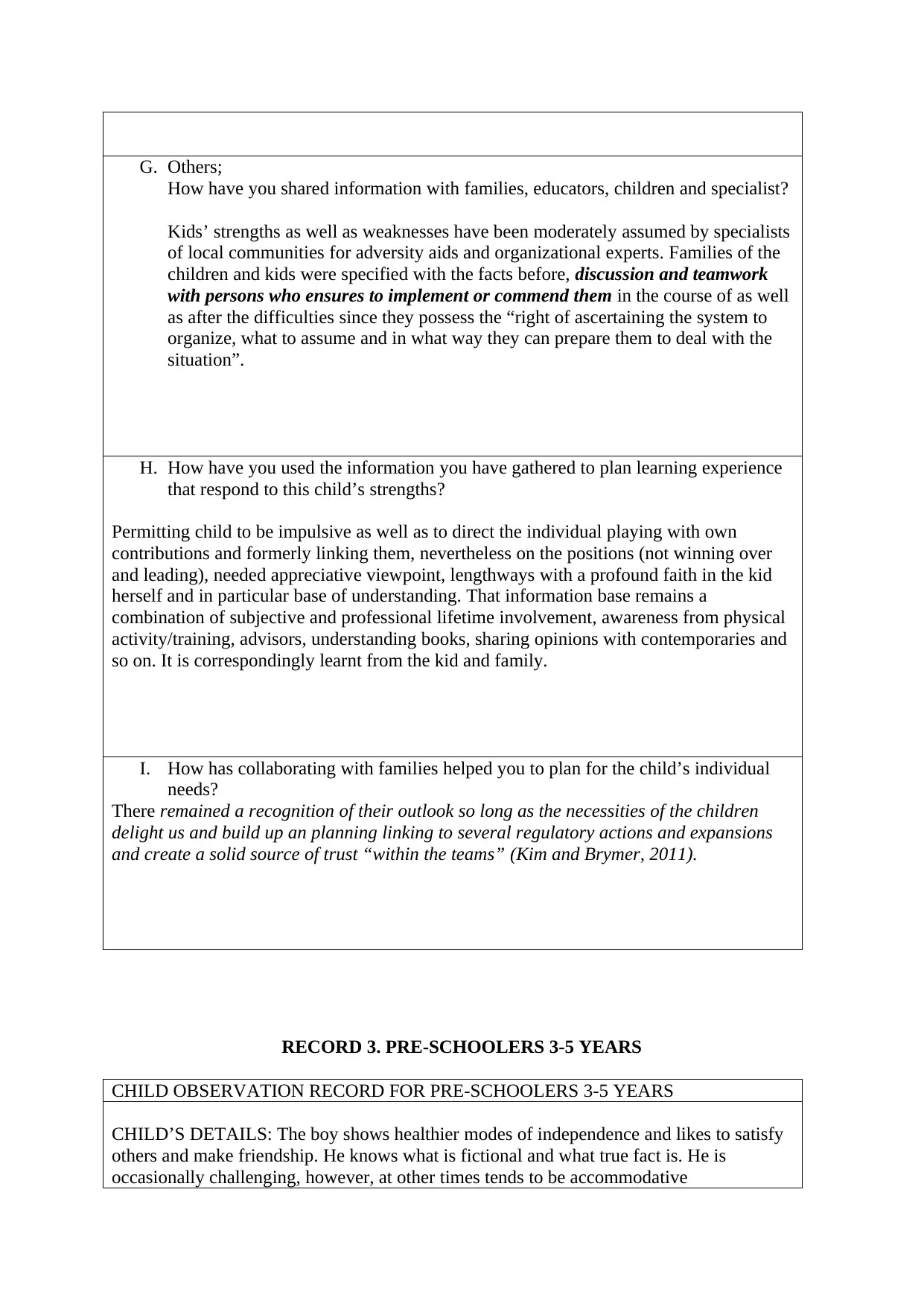
G. Others;
How have you shared information with families, educators, children and specialist?
Kids’ strengths as well as weaknesses have been moderately assumed by specialists
of local communities for adversity aids and organizational experts. Families of the
children and kids were specified with the facts before, discussion and teamwork
with persons who ensures to implement or commend them in the course of as well
as after the difficulties since they possess the “right of ascertaining the system to
organize, what to assume and in what way they can prepare them to deal with the
situation”.
H. How have you used the information you have gathered to plan learning experience
that respond to this child’s strengths?
Permitting child to be impulsive as well as to direct the individual playing with own
contributions and formerly linking them, nevertheless on the positions (not winning over
and leading), needed appreciative viewpoint, lengthways with a profound faith in the kid
herself and in particular base of understanding. That information base remains a
combination of subjective and professional lifetime involvement, awareness from physical
activity/training, advisors, understanding books, sharing opinions with contemporaries and
so on. It is correspondingly learnt from the kid and family.
I. How has collaborating with families helped you to plan for the child’s individual
needs?
There remained a recognition of their outlook so long as the necessities of the children
delight us and build up an planning linking to several regulatory actions and expansions
and create a solid source of trust “within the teams” (Kim and Brymer, 2011).
RECORD 3. PRE-SCHOOLERS 3-5 YEARS
CHILD OBSERVATION RECORD FOR PRE-SCHOOLERS 3-5 YEARS
CHILD’S DETAILS: The boy shows healthier modes of independence and likes to satisfy
others and make friendship. He knows what is fictional and what true fact is. He is
occasionally challenging, however, at other times tends to be accommodative
How have you shared information with families, educators, children and specialist?
Kids’ strengths as well as weaknesses have been moderately assumed by specialists
of local communities for adversity aids and organizational experts. Families of the
children and kids were specified with the facts before, discussion and teamwork
with persons who ensures to implement or commend them in the course of as well
as after the difficulties since they possess the “right of ascertaining the system to
organize, what to assume and in what way they can prepare them to deal with the
situation”.
H. How have you used the information you have gathered to plan learning experience
that respond to this child’s strengths?
Permitting child to be impulsive as well as to direct the individual playing with own
contributions and formerly linking them, nevertheless on the positions (not winning over
and leading), needed appreciative viewpoint, lengthways with a profound faith in the kid
herself and in particular base of understanding. That information base remains a
combination of subjective and professional lifetime involvement, awareness from physical
activity/training, advisors, understanding books, sharing opinions with contemporaries and
so on. It is correspondingly learnt from the kid and family.
I. How has collaborating with families helped you to plan for the child’s individual
needs?
There remained a recognition of their outlook so long as the necessities of the children
delight us and build up an planning linking to several regulatory actions and expansions
and create a solid source of trust “within the teams” (Kim and Brymer, 2011).
RECORD 3. PRE-SCHOOLERS 3-5 YEARS
CHILD OBSERVATION RECORD FOR PRE-SCHOOLERS 3-5 YEARS
CHILD’S DETAILS: The boy shows healthier modes of independence and likes to satisfy
others and make friendship. He knows what is fictional and what true fact is. He is
occasionally challenging, however, at other times tends to be accommodative
⊘ This is a preview!⊘
Do you want full access?
Subscribe today to unlock all pages.

Trusted by 1+ million students worldwide
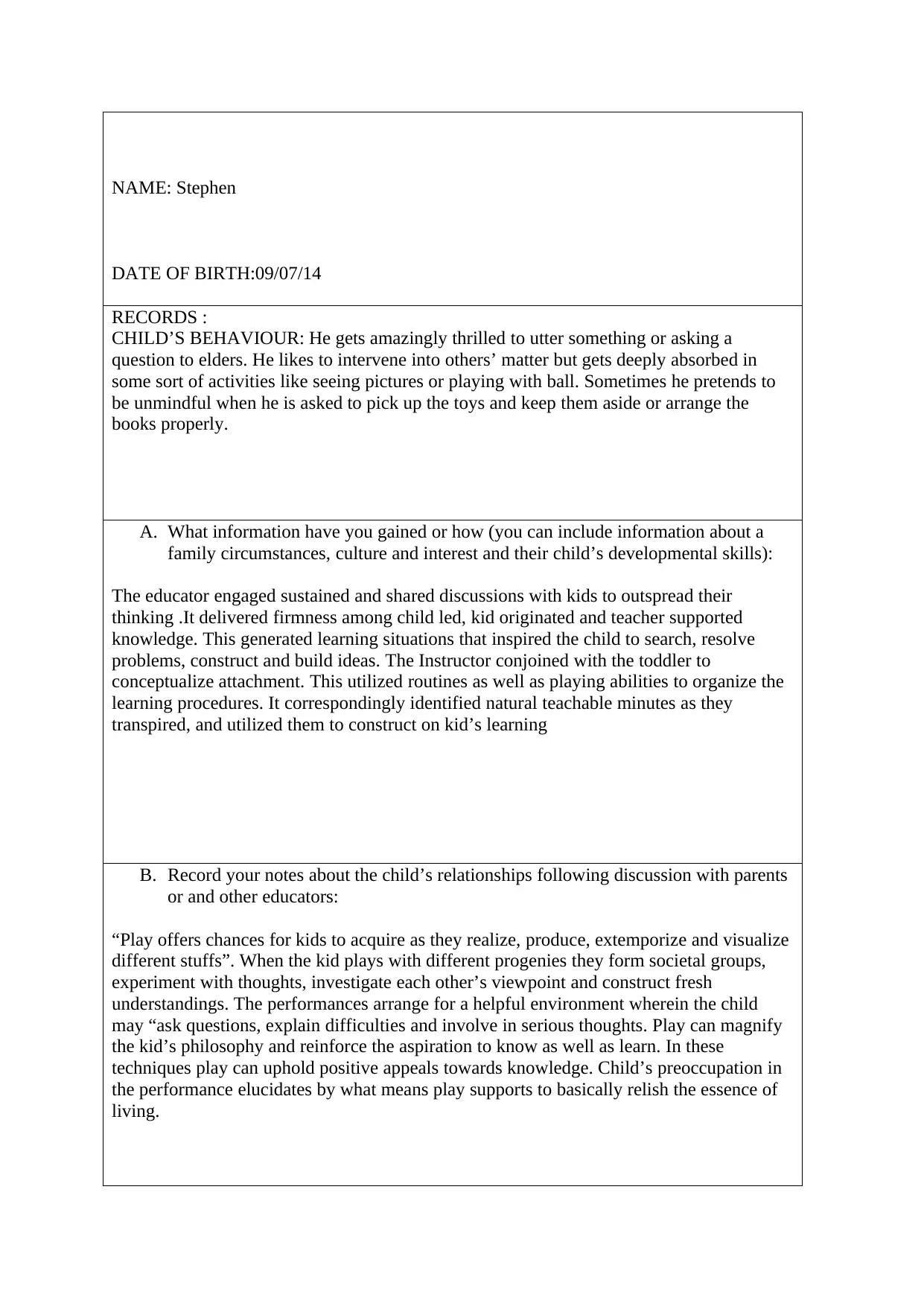
NAME: Stephen
DATE OF BIRTH:09/07/14
RECORDS :
CHILD’S BEHAVIOUR: He gets amazingly thrilled to utter something or asking a
question to elders. He likes to intervene into others’ matter but gets deeply absorbed in
some sort of activities like seeing pictures or playing with ball. Sometimes he pretends to
be unmindful when he is asked to pick up the toys and keep them aside or arrange the
books properly.
A. What information have you gained or how (you can include information about a
family circumstances, culture and interest and their child’s developmental skills):
The educator engaged sustained and shared discussions with kids to outspread their
thinking .It delivered firmness among child led, kid originated and teacher supported
knowledge. This generated learning situations that inspired the child to search, resolve
problems, construct and build ideas. The Instructor conjoined with the toddler to
conceptualize attachment. This utilized routines as well as playing abilities to organize the
learning procedures. It correspondingly identified natural teachable minutes as they
transpired, and utilized them to construct on kid’s learning
B. Record your notes about the child’s relationships following discussion with parents
or and other educators:
“Play offers chances for kids to acquire as they realize, produce, extemporize and visualize
different stuffs”. When the kid plays with different progenies they form societal groups,
experiment with thoughts, investigate each other’s viewpoint and construct fresh
understandings. The performances arrange for a helpful environment wherein the child
may “ask questions, explain difficulties and involve in serious thoughts. Play can magnify
the kid’s philosophy and reinforce the aspiration to know as well as learn. In these
techniques play can uphold positive appeals towards knowledge. Child’s preoccupation in
the performance elucidates by what means play supports to basically relish the essence of
living.
DATE OF BIRTH:09/07/14
RECORDS :
CHILD’S BEHAVIOUR: He gets amazingly thrilled to utter something or asking a
question to elders. He likes to intervene into others’ matter but gets deeply absorbed in
some sort of activities like seeing pictures or playing with ball. Sometimes he pretends to
be unmindful when he is asked to pick up the toys and keep them aside or arrange the
books properly.
A. What information have you gained or how (you can include information about a
family circumstances, culture and interest and their child’s developmental skills):
The educator engaged sustained and shared discussions with kids to outspread their
thinking .It delivered firmness among child led, kid originated and teacher supported
knowledge. This generated learning situations that inspired the child to search, resolve
problems, construct and build ideas. The Instructor conjoined with the toddler to
conceptualize attachment. This utilized routines as well as playing abilities to organize the
learning procedures. It correspondingly identified natural teachable minutes as they
transpired, and utilized them to construct on kid’s learning
B. Record your notes about the child’s relationships following discussion with parents
or and other educators:
“Play offers chances for kids to acquire as they realize, produce, extemporize and visualize
different stuffs”. When the kid plays with different progenies they form societal groups,
experiment with thoughts, investigate each other’s viewpoint and construct fresh
understandings. The performances arrange for a helpful environment wherein the child
may “ask questions, explain difficulties and involve in serious thoughts. Play can magnify
the kid’s philosophy and reinforce the aspiration to know as well as learn. In these
techniques play can uphold positive appeals towards knowledge. Child’s preoccupation in
the performance elucidates by what means play supports to basically relish the essence of
living.
Paraphrase This Document
Need a fresh take? Get an instant paraphrase of this document with our AI Paraphraser
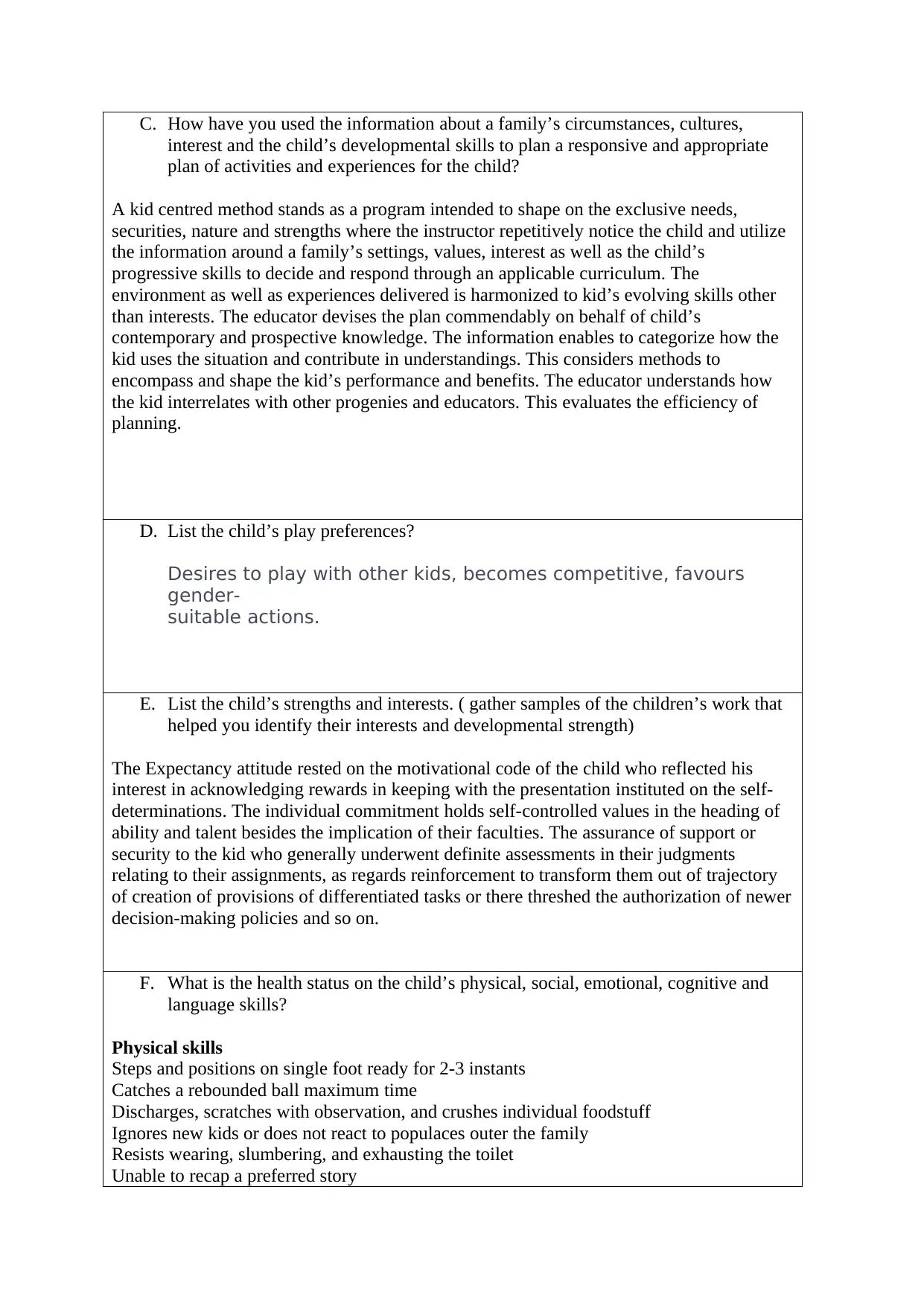
C. How have you used the information about a family’s circumstances, cultures,
interest and the child’s developmental skills to plan a responsive and appropriate
plan of activities and experiences for the child?
A kid centred method stands as a program intended to shape on the exclusive needs,
securities, nature and strengths where the instructor repetitively notice the child and utilize
the information around a family’s settings, values, interest as well as the child’s
progressive skills to decide and respond through an applicable curriculum. The
environment as well as experiences delivered is harmonized to kid’s evolving skills other
than interests. The educator devises the plan commendably on behalf of child’s
contemporary and prospective knowledge. The information enables to categorize how the
kid uses the situation and contribute in understandings. This considers methods to
encompass and shape the kid’s performance and benefits. The educator understands how
the kid interrelates with other progenies and educators. This evaluates the efficiency of
planning.
D. List the child’s play preferences?
Desires to play with other kids, becomes competitive, favours
gender-
suitable actions.
E. List the child’s strengths and interests. ( gather samples of the children’s work that
helped you identify their interests and developmental strength)
The Expectancy attitude rested on the motivational code of the child who reflected his
interest in acknowledging rewards in keeping with the presentation instituted on the self-
determinations. The individual commitment holds self-controlled values in the heading of
ability and talent besides the implication of their faculties. The assurance of support or
security to the kid who generally underwent definite assessments in their judgments
relating to their assignments, as regards reinforcement to transform them out of trajectory
of creation of provisions of differentiated tasks or there threshed the authorization of newer
decision-making policies and so on.
F. What is the health status on the child’s physical, social, emotional, cognitive and
language skills?
Physical skills
Steps and positions on single foot ready for 2-3 instants
Catches a rebounded ball maximum time
Discharges, scratches with observation, and crushes individual foodstuff
Ignores new kids or does not react to populaces outer the family
Resists wearing, slumbering, and exhausting the toilet
Unable to recap a preferred story
interest and the child’s developmental skills to plan a responsive and appropriate
plan of activities and experiences for the child?
A kid centred method stands as a program intended to shape on the exclusive needs,
securities, nature and strengths where the instructor repetitively notice the child and utilize
the information around a family’s settings, values, interest as well as the child’s
progressive skills to decide and respond through an applicable curriculum. The
environment as well as experiences delivered is harmonized to kid’s evolving skills other
than interests. The educator devises the plan commendably on behalf of child’s
contemporary and prospective knowledge. The information enables to categorize how the
kid uses the situation and contribute in understandings. This considers methods to
encompass and shape the kid’s performance and benefits. The educator understands how
the kid interrelates with other progenies and educators. This evaluates the efficiency of
planning.
D. List the child’s play preferences?
Desires to play with other kids, becomes competitive, favours
gender-
suitable actions.
E. List the child’s strengths and interests. ( gather samples of the children’s work that
helped you identify their interests and developmental strength)
The Expectancy attitude rested on the motivational code of the child who reflected his
interest in acknowledging rewards in keeping with the presentation instituted on the self-
determinations. The individual commitment holds self-controlled values in the heading of
ability and talent besides the implication of their faculties. The assurance of support or
security to the kid who generally underwent definite assessments in their judgments
relating to their assignments, as regards reinforcement to transform them out of trajectory
of creation of provisions of differentiated tasks or there threshed the authorization of newer
decision-making policies and so on.
F. What is the health status on the child’s physical, social, emotional, cognitive and
language skills?
Physical skills
Steps and positions on single foot ready for 2-3 instants
Catches a rebounded ball maximum time
Discharges, scratches with observation, and crushes individual foodstuff
Ignores new kids or does not react to populaces outer the family
Resists wearing, slumbering, and exhausting the toilet
Unable to recap a preferred story
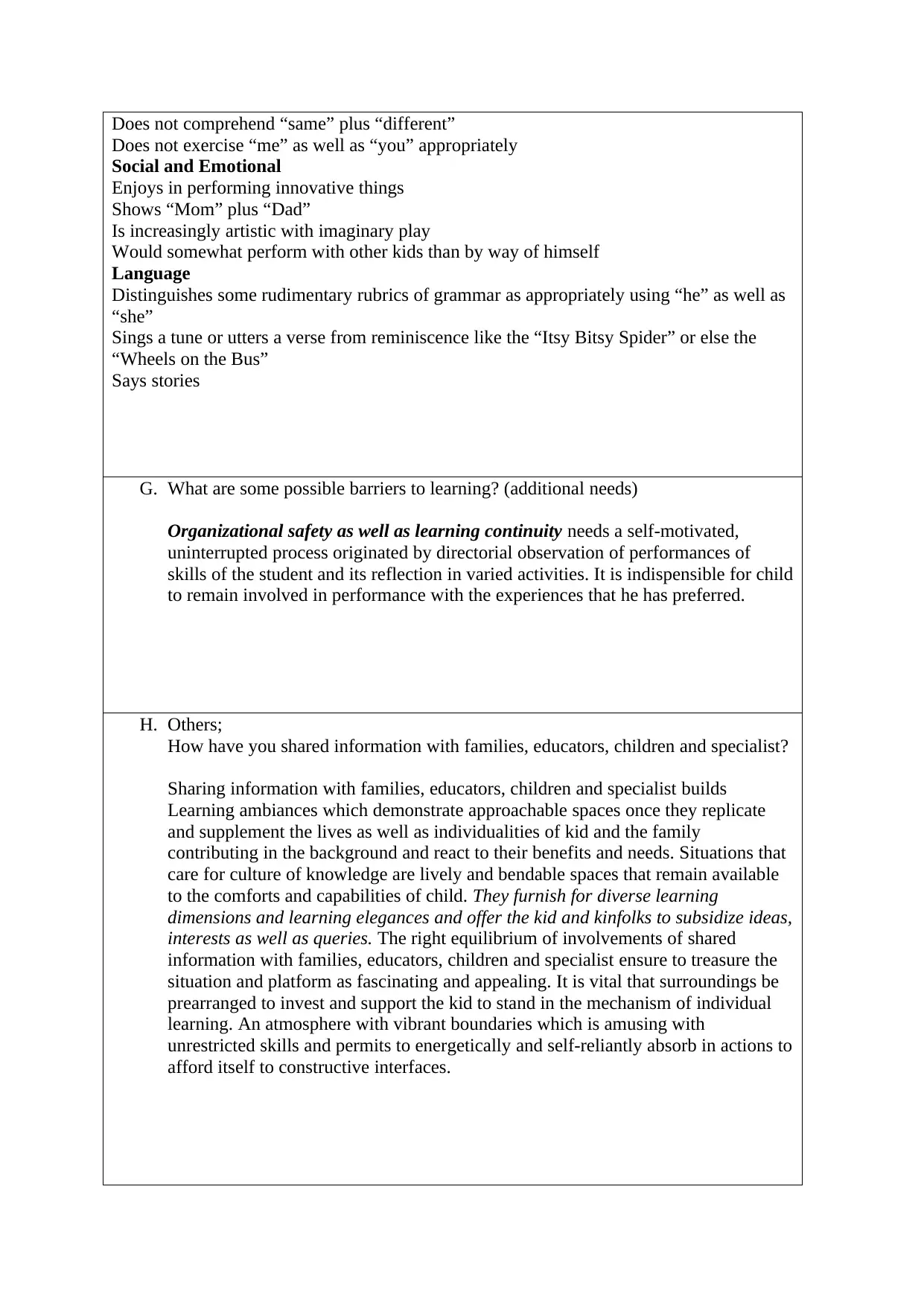
Does not comprehend “same” plus “different”
Does not exercise “me” as well as “you” appropriately
Social and Emotional
Enjoys in performing innovative things
Shows “Mom” plus “Dad”
Is increasingly artistic with imaginary play
Would somewhat perform with other kids than by way of himself
Language
Distinguishes some rudimentary rubrics of grammar as appropriately using “he” as well as
“she”
Sings a tune or utters a verse from reminiscence like the “Itsy Bitsy Spider” or else the
“Wheels on the Bus”
Says stories
G. What are some possible barriers to learning? (additional needs)
Organizational safety as well as learning continuity needs a self-motivated,
uninterrupted process originated by directorial observation of performances of
skills of the student and its reflection in varied activities. It is indispensible for child
to remain involved in performance with the experiences that he has preferred.
H. Others;
How have you shared information with families, educators, children and specialist?
Sharing information with families, educators, children and specialist builds
Learning ambiances which demonstrate approachable spaces once they replicate
and supplement the lives as well as individualities of kid and the family
contributing in the background and react to their benefits and needs. Situations that
care for culture of knowledge are lively and bendable spaces that remain available
to the comforts and capabilities of child. They furnish for diverse learning
dimensions and learning elegances and offer the kid and kinfolks to subsidize ideas,
interests as well as queries. The right equilibrium of involvements of shared
information with families, educators, children and specialist ensure to treasure the
situation and platform as fascinating and appealing. It is vital that surroundings be
prearranged to invest and support the kid to stand in the mechanism of individual
learning. An atmosphere with vibrant boundaries which is amusing with
unrestricted skills and permits to energetically and self-reliantly absorb in actions to
afford itself to constructive interfaces.
Does not exercise “me” as well as “you” appropriately
Social and Emotional
Enjoys in performing innovative things
Shows “Mom” plus “Dad”
Is increasingly artistic with imaginary play
Would somewhat perform with other kids than by way of himself
Language
Distinguishes some rudimentary rubrics of grammar as appropriately using “he” as well as
“she”
Sings a tune or utters a verse from reminiscence like the “Itsy Bitsy Spider” or else the
“Wheels on the Bus”
Says stories
G. What are some possible barriers to learning? (additional needs)
Organizational safety as well as learning continuity needs a self-motivated,
uninterrupted process originated by directorial observation of performances of
skills of the student and its reflection in varied activities. It is indispensible for child
to remain involved in performance with the experiences that he has preferred.
H. Others;
How have you shared information with families, educators, children and specialist?
Sharing information with families, educators, children and specialist builds
Learning ambiances which demonstrate approachable spaces once they replicate
and supplement the lives as well as individualities of kid and the family
contributing in the background and react to their benefits and needs. Situations that
care for culture of knowledge are lively and bendable spaces that remain available
to the comforts and capabilities of child. They furnish for diverse learning
dimensions and learning elegances and offer the kid and kinfolks to subsidize ideas,
interests as well as queries. The right equilibrium of involvements of shared
information with families, educators, children and specialist ensure to treasure the
situation and platform as fascinating and appealing. It is vital that surroundings be
prearranged to invest and support the kid to stand in the mechanism of individual
learning. An atmosphere with vibrant boundaries which is amusing with
unrestricted skills and permits to energetically and self-reliantly absorb in actions to
afford itself to constructive interfaces.
⊘ This is a preview!⊘
Do you want full access?
Subscribe today to unlock all pages.

Trusted by 1+ million students worldwide
1 out of 19
Related Documents
Your All-in-One AI-Powered Toolkit for Academic Success.
+13062052269
info@desklib.com
Available 24*7 on WhatsApp / Email
![[object Object]](/_next/static/media/star-bottom.7253800d.svg)
Unlock your academic potential
Copyright © 2020–2025 A2Z Services. All Rights Reserved. Developed and managed by ZUCOL.





